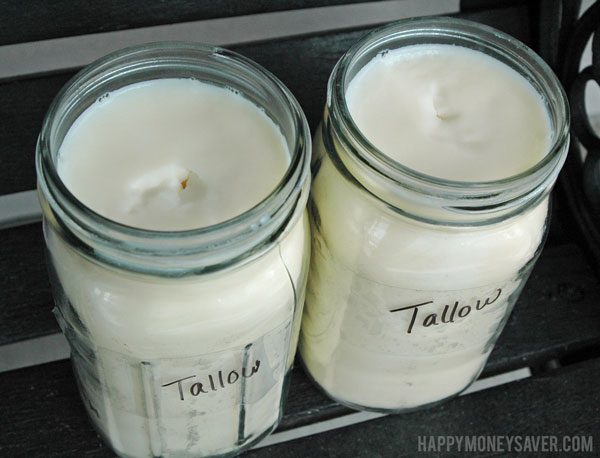
For today’s Happy Homesteading post we are going back in history to learn the long-lost skill of rendering beef tallow fat like many pioneers made & used. Beef tallow was used in cooking as it makes an amazing oil for frying or pastries. They would also use tallow fat for candle making, soap making, moisturizing, keeping cast iron pots from rusting and even for waterproofing leather.
What is Tallow?
“Tallow is the rendered fat of cows, sheep, and other ruminant animals such as deer. It is very solid and waxy at room temperature and can be kept for extended periods without the need for refrigeration. Rendering is the process of gently heating the interior fat tissue, called “suet,” causing the pure oils to melt away from the rest of the tissue.” (Source)Tallow is solid at room temperature, with a texture harder and more waxy than shortening. In fact tallow and lard are rendered the same way, but lard is pig fat slowly melted down and is softer like shortening.
Beef Tallow is a Healthy Fat
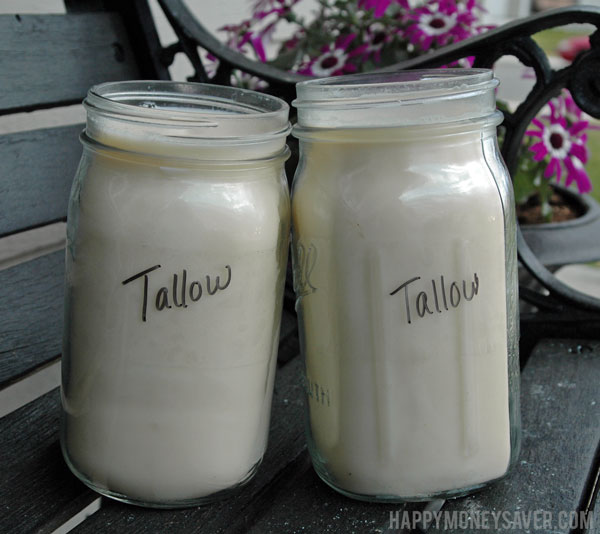
Tallow is the healthy fat that sadly got pushed off the shelves once vegetable oils came around.
Before doing this homesteading series I had honestly never heard of tallow. And when I asked my friends and family about this I just got weird looks. Isn’t it amazing how something that was basically a staple in homes a hundred or two years ago has seemingly been lost or forgotten? After researching I found that beef tallow is actually a very healthy fat full of vitamins and is actually better for you than some of the hydrogenated oils we buy at the stores.
“Tallow is an excellent source of niacin, vitamins B6, B12, K2, selenium, iron, phosphorus, potassium and riboflavin. Grass Fed beef tallow contains high ratio of conjugated linoleic acid (CLA) which is a cancer-resistant agent. Contrary to the popular conception, tallow is good for health as tallow fat is similar to the fat/muscles in the heart. Recent studies have shown that human beings need at least 50% of saturated fats like tallow and lard to keep the heart pumping hale and healthy. Tallow from pasture-raised cows also contains a small amount of Vitamin D, similar to lard. It is also a good source of K2 in its suet form.” (Source)Making Tallow
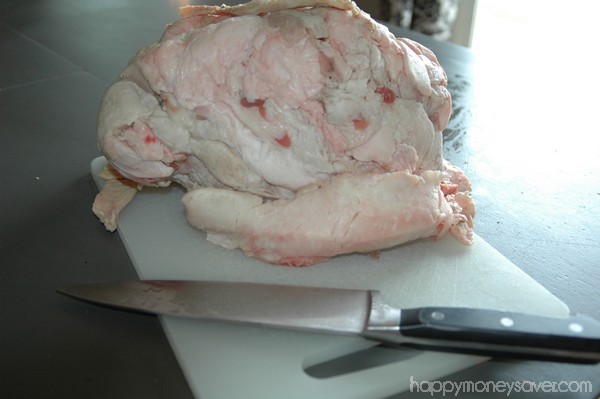
First thing you need is some beef fat. I found a nice local butcher shop, called them up and asked if they had any beef fat. Lucky for me they did and it was only $.67 per lb too. For the nicest and healthiest tallow try to get beef fat from right around the kidneys and preferably from a grass-fed cow. I didn’t ask the butcher at the time I purchased it if this was a grass-fed cow or not, I think I was in shock that I actually found beef fat and that it was so inexpensive. But next time I will ask for sure.
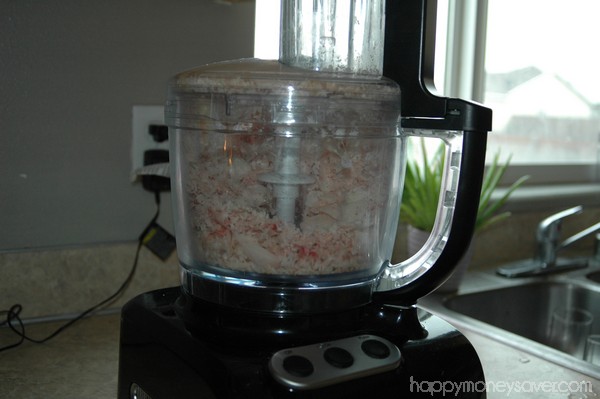
The beef fat I purchased was frozen, so I let it thaw enough that it was still hard but not frozen solid so I could use my food processor to grate it up. If you don’t have a food processor just use a knife and cut the fat into as small of chunks as you can. If there are any pieces of meat you can cut out do it at this stage too.
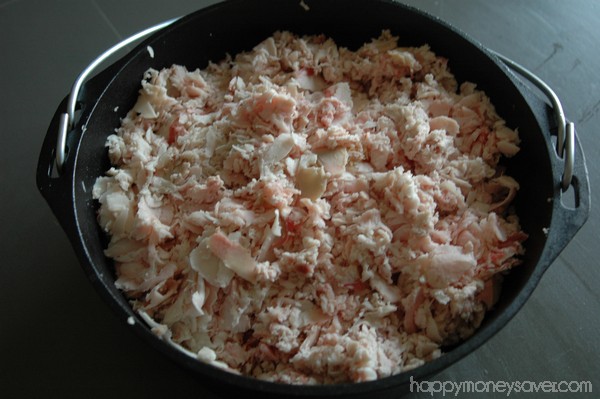
Here is all my beef fat put into my 5 qt. Dutch Oven I purchased. I think there is about 4 lbs of beef fat in there. I filled my pan to the top.
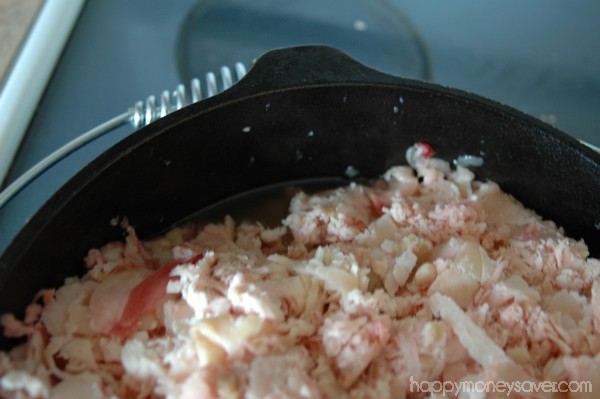
With the heat on low I put the lid on the beef tallow fat and let it start slowly cooking. Here is how it looked after 1 hour. If you had only 1 lb of fat it would look a lot more melted at this stage, but since I have 4 lbs, it is slowly cooking from the bottom.
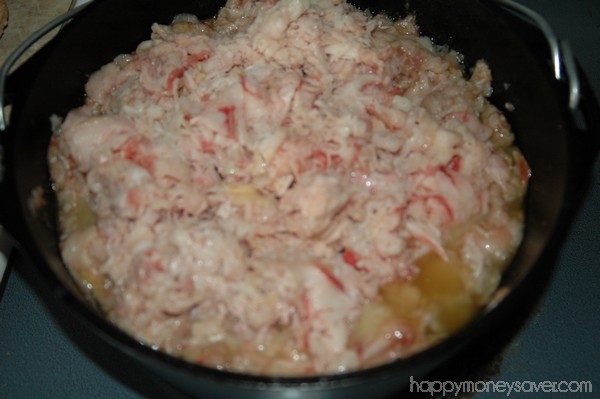
Here it is again after 2 hours. A little more rendered. At this point I took a wooden spoon and mixed the beef tallow fat around a bit. Some people like to take a potato masher and squish it a bit too to help the process along. You don’t want to cook this fast because if it burns it will ruin it all.
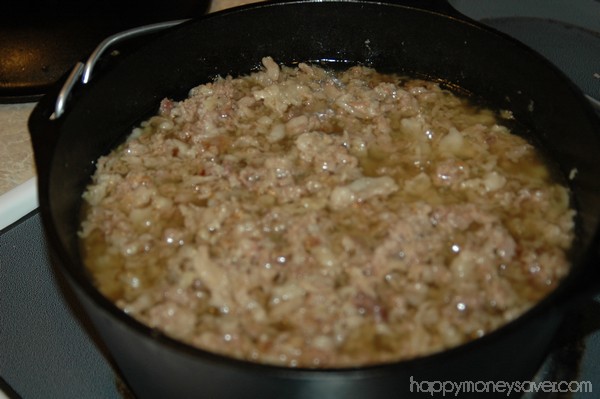
Now its been 4 hours and my house is REALLY starting to smell bad like well..FAT and STINKY OIL. YUCK.

I opened up every window and turned on fans. I can’t stress to you enough how horrible this smelled. At this stage I was just wanting this whole process to be over. I am not kidding. I spent most of the day upstairs just so I couldn’t smell it as much. Then when I did have to go downstairs I actually gagged once from the smell. I am such a baby, aren’t I… 🙂

After about 6-7 hours it was all done. You can tell by all the little browned bits cooked till crispy. The Pioneers called these the cracklin’s. They are basically fried bits of meat and grisle. They would sprinkle a little salt on the cracklins and once cool eat them up. I shuddered at the thought after smelling the fat cooking in the air. I actually lost my appetite with the smell in the air.
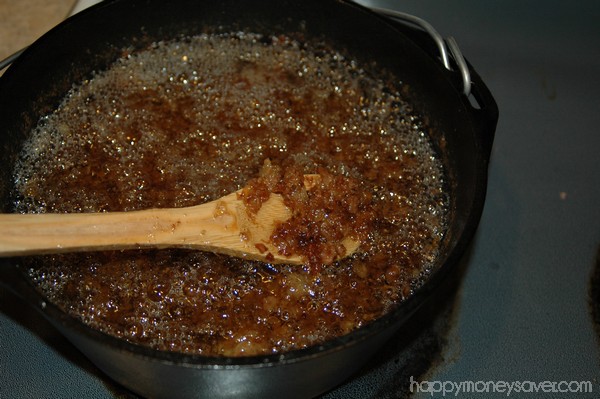
Next is the time to drain all the liquid oil and strain out the cracklin’s. You can use a fine mesh strainer, a paper towel, cheese cloth or what I used: a flour sack towel. I lined the towel over a strainer, which sat over a large bowl.

Then I poured all the hot oil in and strained it. Use oven mitts here, and remember to be safe. This is REALLY HOT oil and can burn you if you are not careful.
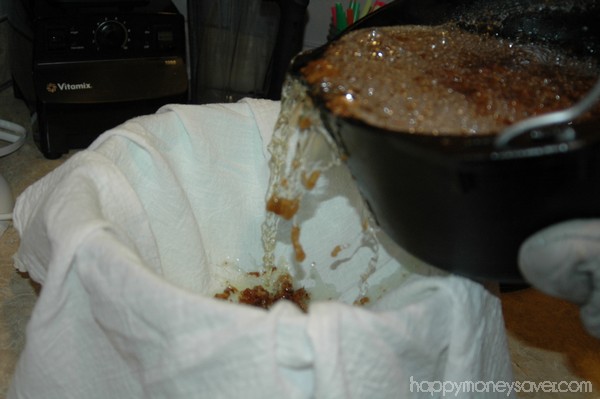
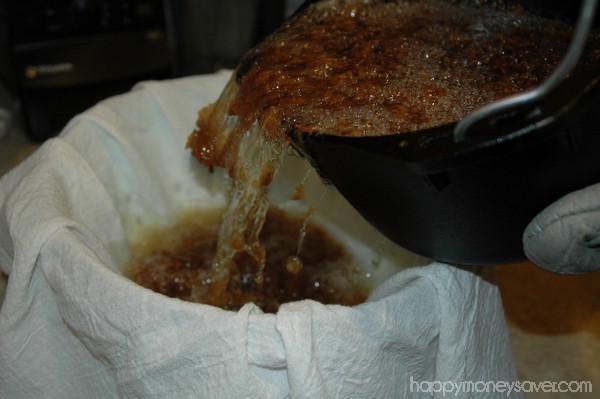

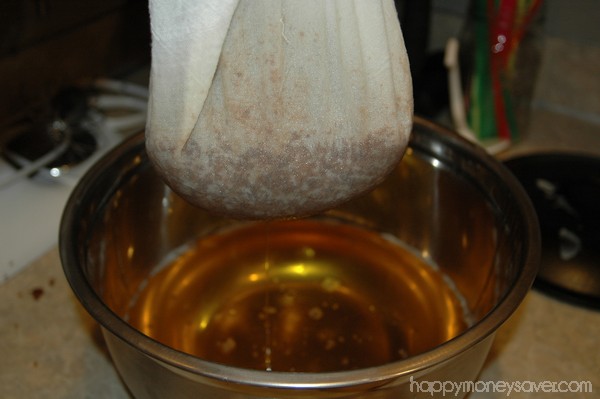
Look at all that lovely yellow liquid tallow left behind after the straining.

It should be a nice yellow color.
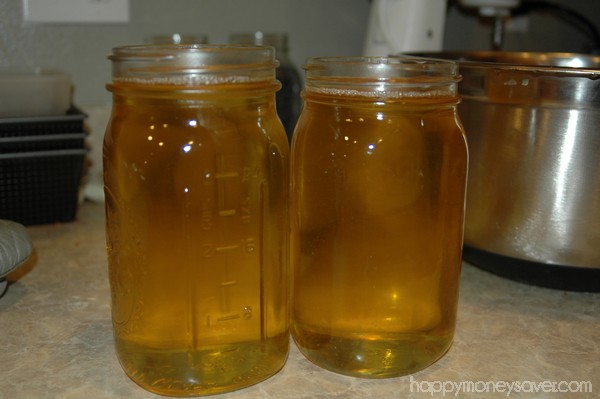
I poured mine into wide mouth glass jars for storage. Then I let it cool all night.
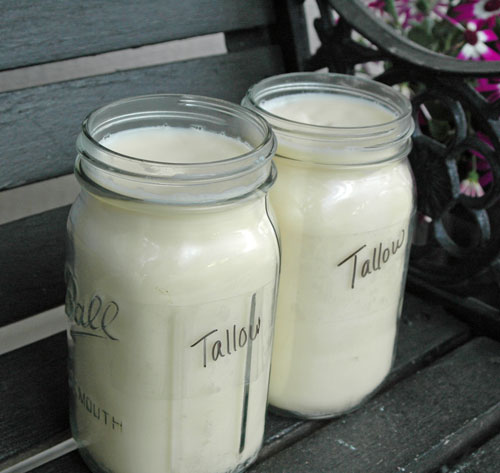
And it turned hard and waxy and white. Isn’t it beautiful??
It was even more beautiful after I deep cleaned my whole kitchen, using vinegar to get the nasty smell out. 😉

Storing Tallow
Beef Tallow is wonderful because as long as you store it in an air-tight container to avoid oxidization it can be at room temperature for up to a year or longer. I have mine in my fridge as it will last even longer there. OR you can pour your tallow fat into ice cube trays and put the frozen cubes into a freezer bag to freeze.
Tallow Soap & Tallow Candles
As many of you might know I made my own homemade soap for the first time last month using a recipe of lye and a variety of store bought oils. I love the soap I made, but I wanted to make soap like the Pioneers and settlers did from long ago using beef tallow. I have heard that homemade tallow soap made from rendering beef tallow is the very best type of soap. It’s strong, its hard and it suds nicely. And I would like to use my own tallow soap instead of using Fels Naptha in my Homemade Laundry Soap recipe as well. So check back, I will be making tallow soap from scratch very soon! Plus I think it might be neat to try to make Tallow candles as well.
So what do you think? Do you have questions? Think this is weird? Please leave a comment with your thoughts!

Ingredients
- Beef Fat preferably from a grass-fed cow and try to get the fat that is from right around the kidneys
Instructions
- Use food processor to grate it up or if you don’t have a food processor just use a knife and cut the fat into as small of chunks as you can.
- If there are any pieces of meat you can cut out do it at this stage too.
- Put beef fat into 5 qt. Dutch Oven, fill pan to the top.
- With the heat on low put the lid on the beef tallow fat and let it start slowly cooking.
- After 2 hours take a wooden spoon and mix the beef tallow fat around a bit. Some use a potato masher and squish it a bit too to help the process along.
- Don’t cook this fast because if it burns it will ruin it all.
- Stir again at about 4 hours.
- After about 6-7 hours it will be done. You can tell by all the little browned bits cooked till crispy.
- Next drain all the liquid oil and strain out the cracklin’s. (Cracklins are basically fried bits of meat and gristle)
- Use a fine mesh strainer, a paper towel, cheese cloth or a flour sack towel and line the towel over a strainer, which should sit over a large bowl.
- Pour all the hot oil in and strain it. It should be a nice yellow color.
- Pour into airtight containers and allow to cool overnight.
- Store it in an air-tight container to avoid oxidization it can be at room temperature for up to a year or longer. You can store it in the fridge as it will last even longer there. OR you can pour your tallow fat into ice cube trays and put the frozen cubes into a freezer bag to freeze.




Comments & Reviews
Jeanine B says
Love this!! Rendering some right now!
Julie Juckes says
Thank you for the tutorial
Ramon says
Thanks for the step by step guide. I am really considering making my own tallow just so I can make candles. 😀
Crystal says
I forgot to add water and salt in my fat when I was rendering it. Can I render it a second time after it hardens and add water and salt then or is it too late at that time? I am concerned about the odour as I am wanting to make moisturizer from it.
Jjule says
I’m going to make suet for the birds w mine.
Thank you for posting
Karrie says
Great idea!
Nunya says
Hi, thanks for the info about beef tallow. I want to know, If it stinks when you make it, does it also stink when you cook with it? If I do this I’ll make it outside 😉
Karrie says
No, it didn’t seem to stink when I cooked with it.
Dana says
Can tallow be made from fat drippings saved from hamburger?
Jacquie says
We raise beef, so each year I make bone broth with all the bones the butcher cuts for me. At the end of this process I have a lot of fat left! Would this fat, which is mostly from bone marrow make good tallow? It seems like such a waste to throw it away, if I can use it for something.
Karrie says
Yes I’m sure that fat would make excellent tallow!
Tim Pearson says
I’m calling the butcher today and ordering some fresh fat. I’ve had the idea but your post really inspired me. I have an outdoor kitchen so hopefully the neighbors won’t mind the drift. Thank you again for the information, I always try to find ways to connect with the lives of my ancestors. I have spent many years off the grid, living sustainably, and following my Viking wanderlust.
Bee well and best wishes,
Tim
Karo says
Very COOL! Thank you! 😃
Bill says
Awesome information. Not sure how soon I’ll make it, but good to have in my brain for reference
Ann says
I don’t notice a “terrible” odor while I’m rendering the fat. I do mine in the oven and end up with crispy bits that are tasty. My neighbors will ask what I’m cooking because as mentioned by another reviewer, it smells like Mom’s Sunday pot roast. I also go in and sample some of the crispier bits while it’s rendering. I roughly chop mine (but not too small). I don’t do low and slow. I start out at an oven temp that I would use for bacon. Once that gets going, I open the oven door and reduce temp to about 225° then resume cooking (with the oven door closed). Comes out perfect every time! The pieces of meat that were trimmed off are saved for later use. The “crunchies” can be seasoned and used as a topping on green salads, in potato and pasta salads, etc. I don’t have dogs but my cats were making frequent visits to the kitchen. Overall, well worth the effort. I paid extra for organic fat that comes from a local ranch that has its own market. They do free home delivery (minimum order, of course) and this last time the rancher made the delivery himself. Showed up in a big ol’cowboy hat, huge belt buckle and nice cowboy boots, driving a very nice refrigerated van with fantastic advertising on the side. Such a lucky find! First-class operation, for sure.
Daffy says
okay, if you do not like the scents of roast beef, or french fries cooked the way they were always cooked until the early 2000s, and the smell of food makes you ill, I suppose it smells ‘bad’. But for 99.999% of the people reading this, the smell of a roast beef dinner cooking or fresh cut french fries will be pleasing. If you have dogs, they will spend those hours drooling.
This process as described will yield yummy cracklings for sure. Anyone who likes bacon, or rinds will also enjoy these. However, for those of you who do not like the smell of meat or home cooked food, the tallow you get from doing it like this WILL absorb and maintain the beefy scent. if you light candles made from this tallow, it will smell like mcdonalds (mcdonald’s fries were always the best because of 1, half cooking, cooling, and then second cooking. and 2, because they used tallow -which everyone did until the mid to late 90s, when they wanted to sell inedible cotton oils and junk veggie oils, which is why all fast food chains had to find a way to reinvent their fries and onion rings to be crispy the way tallow makes them, and veggie oils simply cannot- McDonalds fries are still one of the best fast food fries available, but that is because they re-add beef flavor to their shortening).
If you want clean, scentless tallow, you can do one or two things: first, if you proceed this way and dry render it, and you get the cracklings, then you do not have to figure out what to do with the left overs. to clean it up, you need to clean your pot thoroughly, then add about 6 cups of water and a tablespoon of salt. Set on low heat, and remelt your tallow, let it simmer for an hour, then cool it in the fridge, outside or on the counter. Pop the tallow layer out of your pot or cooling stainless bowl once it hardens. Flip it upside down, and scrap the think layer of impurities stuck to the bottom of it off until it is uniformly white. The left over water will be full of impurities and colour. Discard this. you can collect the scraped impurities and keep it separate for coating and marinating your steaks, roast beefs, potatoes etc. you may opt to run it through a cheesecloth filter again too once remelted. If you dry render as described above, you will need to do this at least 3 times before you are satisfied. But the more times you purify like this, the harder, whiter your tallow will become (at the expense of losing some mass/volume of the finished product), and eventually, it will be completely scentless. This is how you get tallow suitable for cosmetics, such as balms, soap, clear soaps and scentless candles.
Second option: WET render it instead of dry rendering. Instead of throwing it in the ninja and cooking it dry, simply cut it into reasonably small chunks, add the same 6 -8 cups of water to a crock pot / slow cooker, and let it heat up for a bit. Then, just stick blend it. This will reduce the amount of time needed for cooking. it will form a mush or slurry. leave it to simmer in the pot until everything visible sinks to the bottom. Because the water is preventing heat above 100C, and drawing out impurities, you end up with a much paler yellow layer of oil at the top. At this point, pour it through a cheese cloth filter into a large stainless bowl, and then do how ever many purifying runs you want. It is much easier to ‘clean’ the pale yellow tallow, and it will retain much less of the scent / flavour wet rendered, then if dry rendered. Usually a single purifying run will be sufficient. If you remelt, filter and simmer with water and salt two or three times, you will wind up with nearly pure white, hard tallow, that has no scent at all.
The down side of this, is at the end, you do not have cracklings. You have a gross, boiled sludge at the bottom you need to figure out what to do with. I use it as an ingredient for homemade dog food, or in the spring, will place it at the bottom of the troughs when I plant my garden. Lots of people say not to add meat to your compost, but lost of people do anyways. Personally I keep meat waste for gardening separately. Just be sure to rinse the salt off of it if you do this.
two more tips for those of you with sensitive noses: If you goto a butcher shop, ask for only suet aka leaf aka kidney fat only. Before beginning, go through it and cut away any visible meat, blood, or skin. These are the things that leach scent and flavor most heavily into your tallow. Like deep frying fish or fries with oil. The oil absorbs the flavor and smell.
tip 2 for everyone: The butcher will charge you for this fat. Most grocery store chains with a meat section butcher will happily GIVE you any, and all the fat they trim off their cuts. Simply because unlike a butcher shop that uses and sells all of this fat (for sausage, tallow, searing, flavoring, and tend to deal with people who know meat, cuts, quality and candle maker, soap makers etc) very little is wasted. , grocery stores on the other hand, offer limited range of cuts and are not set up to sell anything else. Most grocery store patrons could not tell the difference between a T-bone vs a porter house, or even are there looking for low quality lean cuts, or the highest quality marbled tenderloins only. Their sausages come boxed and premade, hot dogs, kilbassas all come from different factories, lard, suet tallow are sold separately and so forth. As a result, all this valuable fat is just another chore for them to get rid of it. They get a large quater or roast, and trim away any excess fats to discard. Just about every major grocery store butcher will give you 5 gallon buckets free of charge if you show up. Then it is up to you to choose what quality and purity tallow you want, and to trim away anything that may flavor your scent your final tallow.
— wet rendering will reduce your bad smell problem to a fraction of the dry rendering. And plain, unscented candles or lip balm made from purified wet rendered tallow should have zero smell.
ann says
Great post. Please read mine.
No1g8r says
I picked up a whole brisket at Kroger yesterday for $1.97/lb. I used a filet knife to cut most of the chunks of fat out so that I could use the lean meat for canning beef stew. A 13.7# brisket yielded 9.3# of stew meat and 4.4# of beef fat. I tended about 1/3 of it yesterday and it made the house smell as if I had pan fried up fresh hamburgers. I’ll probably render the rest outside today on a hot plate and see what happens.
Cyndi says
When I was pregnant with my first child the smell of cooking meat made my horribly sick……… Karrie, do you have any good news to share???
Great article!
Happy-Money-Saver says
Haha! Nothing to share here! LOL!
Alexandra Abraham says
There is another way oif ensuring your fat has virtually no smell – if any – when rendering it down. This works particularly well for suet/organ fat. Cut it into manageable chunks – about one-and-a-half inch cubes – and soak them in cold water for 12 days. Stir gently, then change the water daily.
Whichever method you use will take some work, but by soaking the far in cold water every day, you can just put it into a pot and render it, without any worry of any smell.